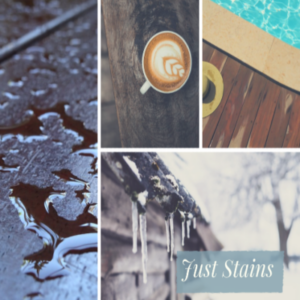Understanding Chemical and Iron Stains on Lumber

Chemical stains include a variety of discolorations that occur in wood during drying but are typically not noticed under the drying process is over. A previous blog focused on sticker stain so this blog will address other chemical stains.
Interior Graying
This is most common in southern oaks, hackberry, maple, and ash, but can also occur in many other wood species.
Brown Stain (Coffee Stain)
This stain is most common in white pine and thicker boards of any pine species.
Chemical Stains
Chemical stains develop when naturally occurring chemicals in wood react with air (known as an enzymatic oxidation reaction) to form a new chemical compound that is typically dark in color. A key point in the formation of these stains is that the chemical precursors, which develop in the wood and will eventually lead to discoloration are develop above 40% moisture content. Once the precursors develop, staining is inevitable. Stain control must be started at high moisture contents.
It is difficult, and sometimes impossible, to detect when the precursors have formed. Inspection of air-dried lumber may show no sign of discoloration. However, the stain may still be present after kiln drying. However, the surface of the lumber may already be below 40% moisture content when the precursors are developed. In this case, the stain will develop only in the interior of the board and will not be evident until the lumber is machined – planed or ripped.
A stain can be treated with a drop or two of concentrated oxalic acid to determine if the stain is chemical or fungal. The acid will bleach chemical and iron tannate stains but will not change fungal stains.
Stain Requirements
Chemical stains will develop when wood is slowly dried and temperatures are warm to hot. These conditions will trigger an enzymatic oxidation reaction. The longer poor drying conditions exist, the more the reaction proceeds inward and the darker the stain becomes on the surface. To control chemical staining, attention must be focused on the causes of, and cures for, slow drying, particularly when the lumber is above 40% moisture content. Slow drying can be caused in part by:
- High relative humidity in the initial stages of drying.
- Slow air velocities and/or long air flow paths.
- Snow melting schedules using high relative humidity.
- Overloaded predryers or kilns that prevent the kiln to quickly achieve the desired relative humidity.
- Ambient conditions that are warm and humid.
High Relative Humidity
The most frequent cause of chemical staining is relative humidities in predryers or kilns that are too high. Good kiln controls are essential because the conditions on the controls must accurately represent the conditions in the kiln. For most light-colored woods, the initial settings are 130 F with a 10 F wet bulb depression (65% relative humidity). Predryer conditions, which use a lower dry bulb temperature, must be even lower in humidity. Failure to achieve this initial humidity when the wood is warm will likely lead to staining. If kept at high humidities for very long, the staining process will progress.
Air Flow
The relative humidity may be acceptable when the air enters a load of lumber. Because of slow air velocity and/or long air travel paths before the air is reheated, however, the humidity in the air will rapidly increase. In the interior of the pile, the humidity can be high enough to cause stain. Never dead stack green lumber.
Snow Melting
A snow or ice melting schedule (also called lumber thawing) is ideal for stain development. These schedules are often at 80 F and 100% relative humidity for 24 hours.
Overloaded Predryer
A lumber predryer or kiln that is loaded with too much wet lumber or a drying schedule that requires an impossible to achieve low wet bulb temperature, especially during hot and humid weather can result in excessively high humidity in the kiln.
Humid Weather
Springtime weather often provides very good air-drying. An occasional spell of warm temperature and high humidity can provide excellent conditions for stain.
Meet the Author
Dr. Todd Shupe is the President of Wood Science Consulting, LLC. He is a well-recognized expert on wood forensics, wood preservation, wood decay and degradation, and wood species identification. He has a broad background in new product development, quality management, and marketing and sales in both the public and private sectors. For more information please visit DrToddShupe.com.
We welcome your comments below.
Thank you for visiting. We trust that you have enjoyed reading our articles.
Liked this post? Read more below or search for more topics . . .

